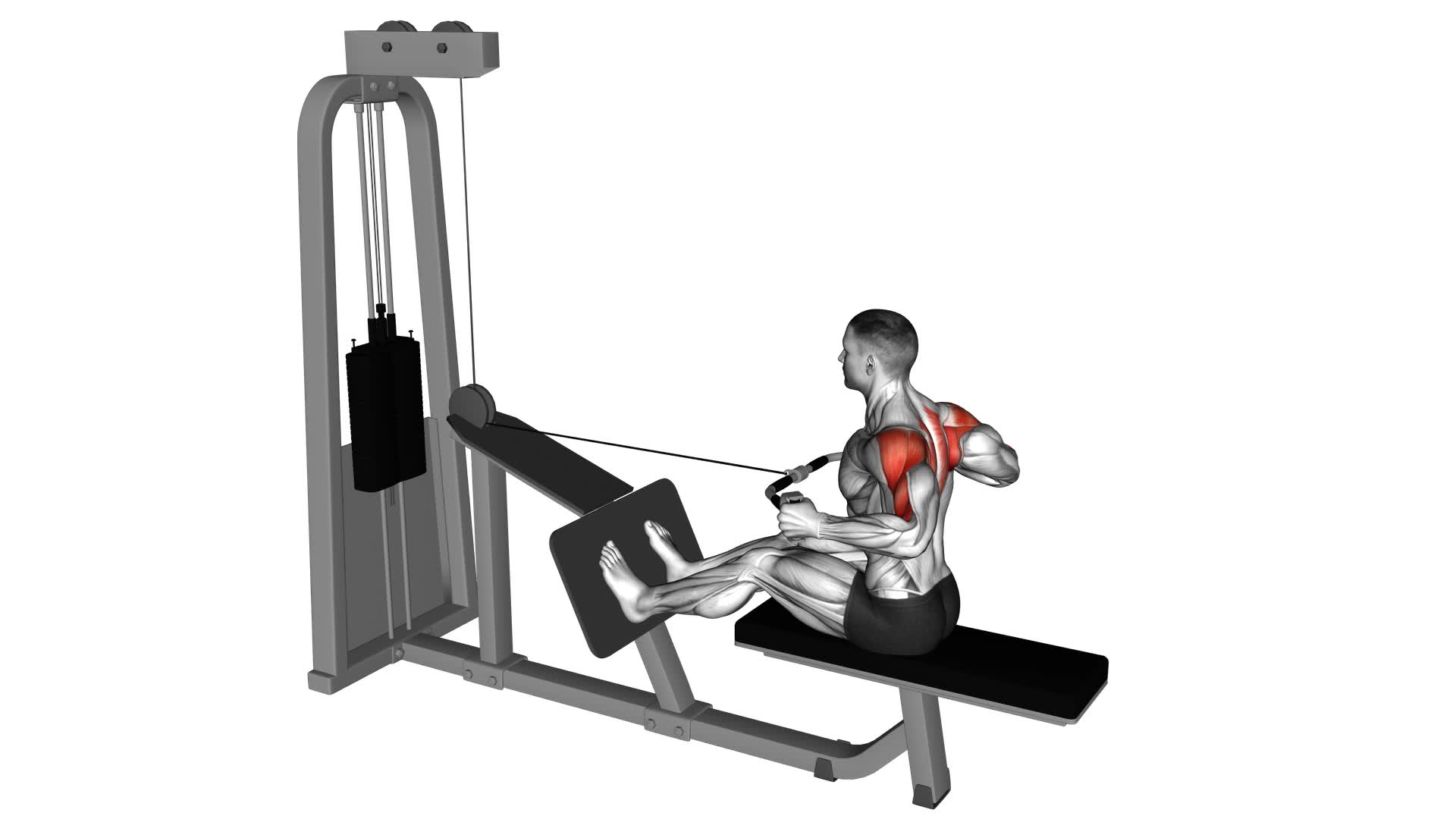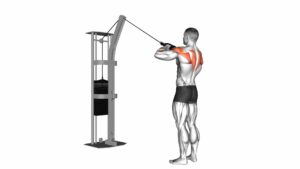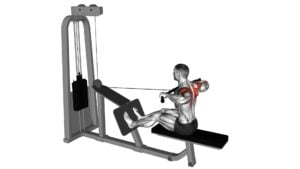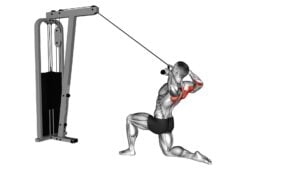Cable Rear Delt Row (Parallel Bar) – Video Exercise Guide & Tips

In this video exercise guide, you'll learn how to perform the cable rear delt row using a parallel bar. This exercise specifically targets and strengthens your rear deltoids, helping to improve posture and overall shoulder stability.
Watch This Exercise Video
You'll discover proper form and technique, as well as variations and modifications to customize your workout. Get ready to elevate your rear delt training with this effective and efficient exercise.
Let's dive in!
Key Takeaways
- Cable rear delt row targets and strengthens the rear deltoids.
- Proper form and technique involve using a shoulder-width grip on the parallel bar, keeping elbows close to the body, and focusing on controlled movements.
- Adjusting the angle of the parallel bar can target different areas of the rear delts.
- Effective rear delt training involves maintaining a neutral spine, squeezing the shoulder blades together, starting with appropriate weight, and avoiding excessive momentum.
Benefits of Cable Rear Delt Row
Experience the numerous benefits of the Cable Rear Delt Row for strengthening your deltoid muscles and improving your overall upper body strength. Cable rear delt row benefits aren't to be underestimated. The rear deltoids, or posterior deltoids, are often overlooked in training routines, but they play a crucial role in maintaining proper shoulder alignment and preventing injuries. By incorporating cable rear delt rows into your workout regimen, you can specifically target and strengthen these muscles.
One of the main benefits of cable rear delt rows is that they allow for a full range of motion, ensuring that you engage all the muscle fibers in your rear deltoids. This exercise also helps to improve your posture by counteracting the effects of daily activities that often promote rounded shoulders. Strengthening your rear deltoids can help to alleviate shoulder pain and reduce the risk of injuries, especially for those who engage in activities that involve repetitive overhead movements, such as swimming or throwing sports.
Additionally, cable rear delt rows can contribute to a more balanced and well-rounded physique. By focusing on the rear deltoids, you can create a more symmetrical appearance and achieve a more aesthetically pleasing upper body. So, don't overlook the importance of rear delt training and incorporate cable rear delt rows into your workout routine to reap these benefits.
Proper Form and Technique
To perform the Cable Rear Delt Row exercise with proper form and technique, you should use a shoulder-width grip on the parallel bar. This will ensure that you engage the correct muscles and maximize the effectiveness of the exercise.
Here are some important points to keep in mind:
- Common Mistakes:
- Avoid using a wider grip, as it can put unnecessary strain on your shoulders and decrease the effectiveness of the exercise.
- Don't let your elbows flare out to the sides. Keep them close to your body to target the rear delts more effectively.
- Avoid using excessive momentum or jerking motions. Focus on controlled and smooth movements to engage the muscles properly.
- Equipment Needed:
- You'll need a cable machine with a parallel bar attachment.
- Adjust the weight stack according to your fitness level and goals.
By following these guidelines, you can ensure that you perform the Cable Rear Delt Row exercise correctly and minimize the risk of injury.
Remember to start with a weight that challenges you but allows you to maintain proper form throughout the exercise. As you become more comfortable, you can gradually increase the weight to continue progressing and building strength in your rear delts.
Variations and Modifications
For variations and modifications of the Cable Rear Delt Row exercise, you can adjust the angle of the parallel bar to target different areas of your rear delts. By using different equipment, such as an adjustable cable machine, you can change the height and angle of the parallel bar to challenge your muscles in different ways.
One variation is the high cable rear delt row, where you set the parallel bar at a higher position. This targets the upper portion of your rear delts and helps to build width and thickness in that area. On the other hand, lowering the parallel bar to a lower position focuses more on the lower portion of your rear delts, helping to create a more balanced and well-rounded look.
It's important to note that common mistakes when performing the Cable Rear Delt Row include using too much weight, which can lead to poor form and injury. Additionally, avoid using momentum to pull the weight, as this takes the focus away from your rear delts and reduces the effectiveness of the exercise. Instead, focus on a controlled movement, squeezing your shoulder blades together at the top of the movement for maximum muscle activation.
Remember to always start with a light weight and gradually increase as you become more comfortable and confident with the exercise. And as with any exercise, consult with a fitness professional if you have any concerns or questions about variations and modifications.
Tips for Effective Rear Delt Training
To effectively train your rear delts, focus on proper form and technique during the Cable Rear Delt Row exercise. This will ensure that you're targeting the right muscles and maximizing your workout. Here are some tips to help you train your rear delts effectively:
- Maintain a neutral spine: Keep your back straight and avoid rounding your shoulders. This will help engage your rear delts more effectively.
- Squeeze your shoulder blades: As you pull the cables towards your chest, focus on squeezing your shoulder blades together. This will activate your rear delts and ensure they're being worked.
- Use appropriate weight: Start with a weight that challenges you but allows you to maintain proper form. Gradually increase the weight as you get stronger.
Common mistakes to avoid when training your rear delts include using too much momentum, neglecting proper form, and not using the correct equipment. To perform the Cable Rear Delt Row, you'll need a cable machine with a parallel bar attachment. This equipment will allow you to target your rear delts effectively and safely.
Sample Workout Routine
Create a well-rounded sample workout routine to effectively target your rear delts.
When planning your workout, it's important to consider exercise selection and the overall structure of your routine. To maximize the development of your rear delts, include exercises that specifically target this muscle group, such as cable rear delt rows.
Start your workout plan with a thorough warm-up to prepare your muscles for exercise. This can include dynamic stretches and mobility exercises. Then, move on to compound exercises that engage multiple muscle groups, such as bent-over rows or pull-ups. These exercises will help you build overall strength and stability.
After completing compound exercises, focus on isolation exercises that specifically target your rear delts. Cable rear delt rows are an excellent choice for this purpose. You can also incorporate exercises like reverse flyes or face pulls to further target this muscle group.
When selecting exercises, consider using a variety of equipment, such as cables, dumbbells, or resistance bands. This will help you target your rear delts from different angles and stimulate muscle growth.
Remember to listen to your body and adjust the weight and intensity as needed. Aim to perform 2-3 sets of each exercise, with 8-12 repetitions per set. Rest for about 60-90 seconds between sets to allow for recovery.
Frequently Asked Questions
What Are the Common Mistakes to Avoid While Performing the Cable Rear Delt Row Exercise?
When performing the cable rear delt row exercise, it's important to avoid common mistakes that can hinder your progress. By focusing on proper form and technique, you can maximize the benefits of this exercise.
Some common mistakes to avoid include using too much weight, rounding your back, and not fully extending your arms.
How Often Should I Include Cable Rear Delt Rows in My Workout Routine?
To determine the frequency of including cable rear delt rows in your workout routine, consider your overall training goals and the needs of your shoulders. These rows can be beneficial for strengthening and developing the rear delts, improving posture, and promoting balanced shoulder development.
Depending on your schedule and recovery abilities, you could incorporate this exercise once or twice a week. Remember to listen to your body and adjust the frequency as needed to avoid overtraining.
Can Cable Rear Delt Rows Help in Improving Posture?
Cable rear delt rows can help improve your posture by enhancing shoulder stability. These exercises target the muscles in your upper back, including the rear deltoids, which play a crucial role in maintaining good posture.
Is It Necessary to Use a Parallel Bar for Performing Cable Rear Delt Rows, or Can I Use Other Equipment?
You don't have to use a parallel bar for cable rear delt rows. There are alternative equipment options available.
However, using a parallel bar can offer certain benefits. It provides stability and allows for a controlled range of motion. Additionally, the parallel bar helps to isolate and target the rear deltoid muscles effectively.
Experiment with different equipment to find what works best for you and your fitness goals.
Are There Any Specific Warm-Up Exercises Recommended Before Performing Cable Rear Delt Rows?
Before performing cable rear delt rows, it's important to warm up to prevent injury and maximize effectiveness. Start with some light cardio to get your blood flowing and loosen up your muscles.
Then, do some dynamic stretches for your shoulders and upper back to increase flexibility.
Incorporating cable rear delt rows into your shoulder routine offers several benefits, such as targeting the rear delts for improved strength and posture.
To engage the rear delts properly, focus on squeezing your shoulder blades together and pulling the cables towards your body.
Conclusion
In conclusion, the cable rear delt row is an effective exercise for targeting and strengthening the rear deltoid muscles. By maintaining proper form and technique, individuals can maximize the benefits of this exercise.
Additionally, variations and modifications can be incorporated to add variety and challenge to the workout routine.
Following these tips and including the cable rear delt row in a well-rounded workout program can help individuals achieve stronger and more defined rear delts.

Author
Years ago, the spark of my life’s passion ignited in my mind the moment I stepped into the local gym for the first time. The inaugural bead of perspiration, the initial endeavor, the very first surge of endorphins, and a sense of pride that washed over me post-workout marked the beginning of my deep-seated interest in strength sports, fitness, and sports nutrition. This very curiosity blossomed rapidly into a profound fascination, propelling me to earn a Master’s degree in Physical Education from the Academy of Physical Education in Krakow, followed by a Sports Manager diploma from the Jagiellonian University. My journey of growth led me to gain more specialized qualifications, such as being a certified personal trainer with a focus on sports dietetics, a lifeguard, and an instructor for wellness and corrective gymnastics. Theoretical knowledge paired seamlessly with practical experience, reinforcing my belief that the transformation of individuals under my guidance was also a reflection of my personal growth. This belief holds true even today. Each day, I strive to push the boundaries and explore new realms. These realms gently elevate me to greater heights. The unique combination of passion for my field and the continuous quest for growth fuels my drive to break new ground.







